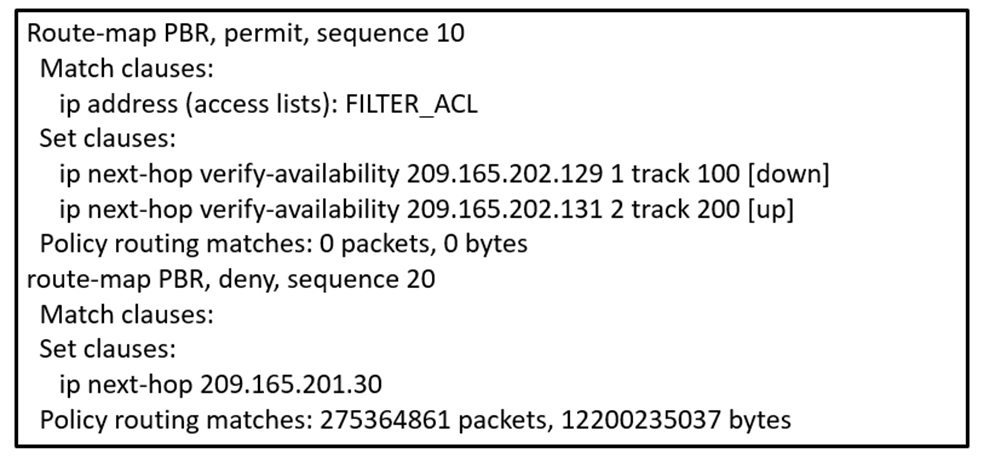Refer to the exhibit. An engineer has configured policy-based routing and applied the configuration to the correct interface. How is the configuration applied to the traffic that matches the access list?

Refer to the exhibit. An engineer has configured policy-based routing and applied the configuration to the correct interface. How is the configuration applied to the traffic that matches the access list?

The route map sequence 10 specifically matches the traffic from the access list FILTER_ACL. Since no packets have matched this sequence (0 packets, 0 bytes), the traffic is not being processed by this route map entry. As a result, traffic that does not match sequence 10 falls into sequence 20. Sequence 20 is a deny statement which means the set clauses are not applied, and policy-based routing (PBR) is bypassed. Consequently, the traffic that matches the access list FILTER_ACL will be forwarded using the normal routing table lookup.
It's tempting to select C because of the policy routing matches. But the question explicitly states: How is the configuration applied to the traffic that matches the access list? So the traffic matching the ACL will choose the second next-hop. Again, trick questions designed to mess up your mind and make you fail the exam to generate revenue for Cisco.
I think It's a Reliable PBR with IP SLA.
We are not seeing any matched to sequence 10. 0 packets and 0 bytes, so it is matching to the deny sequence 20. Because it is a deny statement, teh set condition isn't applied and PBR is not used. Therefore we do a standard routing lookup.
A is correct because seq 10 did not have backetss matches and seq 20 deny allrady then backets will routed based on the normal routing table
As mentioned before seq 20 doesnt match the ACL, which the question is about
Answer is A it's match deny policy so is A
look at polcy routing matches. too many packets hit the policy
Help please we don't see match in Denison is A
Doesn't matter? The question is asking *How is the configuration applied to the traffic that matches the access list* so its specifically asking about the traffic matching the acl...
The given answer is correct. "... matches the access list. ACL is matched. route-map statement is permit and the second track is up. Its D
D is correct
D is correct. Here is no question how traffic will be routed. The question about how it will be routed if it is matched the ACL
seems to be the best
The correct answer is: D
The correct Anwer is A, beacause, we don´t see any maches in PBR 10 and The PBR 20 Deny statement dont mach with any ánd send the traffic for Route table.
As Jokker stated. This is specific to the ACL defined, Sequence 20 does not have an ACL to match to. Even though there are no MATCH hits on the Sequence 10, it is the only one that has an ACL.
D is correct